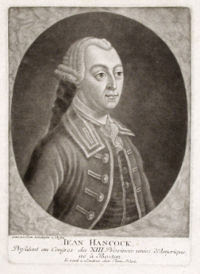Kempton Called Back to Service
Walter Spooner (1723-1803) was a representative to the Massachusetts General Court from the town of Dartmouth, which contained what’s become New Bedford. On 24 Jan 1776 Spooner wrote from Watertown, where the legislature was meeting, to Capt. Thomas Kempton of Dartmouth:
Sir—Kempton had just finished eight months of service as a captain at the siege of Boston. He hadn’t reenlisted in the Continental Army at the end of 1775. But Gen. George Washington had asked the New England colonies to raise some militia regiments for a short period—two months in this case—to augment his depleted Continental forces. So the General Court gave Kempton a promotion from captain to lieutenant colonel and told him to report again.
It is with pleasure that I have it in my power to informe you that you are appointed a Lieut Colo. of a Regiment of Men to be raised as temporary reenforcement of men to continue for the Space of two months or until the first day of April next (if needed so long.) Jacob French is appointed Chief Colo. 50 men are to be raised in the County of Bristol, the other part are raised in the County of Cumberland, the Majr of F’[s] Regiment is appointed in the County & the Adjitent also, the other officers time would fail me to give you a perticuler account off.
Esqr. Baylies is appointed by the Court to come into the Town of Dartmouth in order to raise men. He will furnish you with more particular accompts. I also expect to be at home this weak and shall be glad to see you before I return again. Tho this appointment may be unexpected, yet I hope it will not be disagreeable. I wish your conduct may anser the expectations of your friends, for in your appointment I have taken no small part.
I with truth subscribe my Selfe
Your Friend,
W. Spooner.
Yesterday I quoted how Kempton’s grandson understood the way his Revolutionary War service started, as opposed to the slightly different story that documents from the time suggest. When Daniel Ricketson wrote his 1858 History of New Bedford, Kempton’s son told him that his father had “left service at the evacuation of Boston by the British troops” because of “a failure of health.” In fact, Lt. Col. Kempton’s term was up in April 1776.
It’s possible that health concerns played a role in Thomas Kempton’s decision not to reenlist in the Continental Army at the end of 1775 and later, though he was only in his mid-thirties and lived another thirty years. It’s also possible that Kempton had other reasons: a feeling that he’d done his part, pressure to be home with his family, better opportuntities in privateering (he had been a whaling captain years before) or civil government. But he did serve again in early 1776. When he died in New Bedford in 1806, the Columbian Centinel newspaper called him “Col. THOMAS KEMPTON, an aged and respectable inhabitant of that town.”
Today at 12:30 I’ll speak at Anderson House in Washington, D.C., about one of Thomas Kempton’s souvenirs of his military service in 1775: an engraved powderhorn now owned by that museum.












